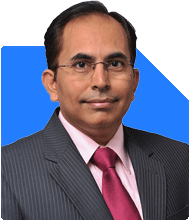Ramalingam Kalirajan |8365 Answers |Ask -Follow
Mutual Funds, Financial Planning Expert - Answered on Apr 27, 2024
He has an MBA in finance from the University of Madras and is a certified financial planner.
He is the director and chief financial planner at Holistic Investment, a Chennai-based firm that offers financial planning and wealth management advice.... more

Hello Sir, I am 46 Y old . Recently i lost my job and serching for Job . I have 3 Flats , 80 L , 80L, 1.5 Cr . I have loan of 2 nd flat 6 L and Vila Loan 1,18 Cr . I have savings 15 L Mutual Fund, 9 L FD. 10L Govenment bonds, 17.5 L PPF(Eife). 7.5 L PPF(Myself), 2.5L gold bond, 2.5 L shares. EPF 72 L . I require 40 L for my daugter education in 4 year Span starting from 2024-2028. I require 40 L for my son education 2028-2032. If i sell my two flats and do loan free the Vila , I left with 40 L . I see visiblity of 30 L for my son and daughter education and left with 1.2Cr as saving . For house hold my wife earn 52 K which is ok for us monthy usage. Please help me a programe so that i can full fill my retirement objection ( 50K) per month . I may get job or not but want to secure the future of children as wella s my retietment . Please suggest .
Education Fund for Children:
You have visibility of 30 lakhs for your children's education, which is a good start. To bridge the gap, consider allocating a portion of your remaining savings towards an education fund. You can invest in diversified mutual funds or fixed income instruments based on your risk tolerance and investment horizon.
Additionally, explore scholarship opportunities and educational loans to reduce the financial burden.
Debt Management:
Selling two flats to become loan-free on the villa is a prudent move to reduce debt burden. It will also free up cash flow for other financial goals.
Consider refinancing or restructuring the villa loan to reduce interest payments and accelerate debt repayment.
Retirement Planning:
With 1.2 crores in savings, you can create a retirement corpus through systematic investments in a combination of equity and debt instruments.
Allocate a portion of your savings towards diversified equity mutual funds for long-term growth potential. Aim for a balanced portfolio to manage risk effectively.
Consider investing in debt instruments like PPF, government bonds, and fixed deposits for stability and regular income during retirement.
Maximize contributions to EPF or consider opening a Voluntary Provident Fund (VPF) account to enhance retirement savings.
Emergency Fund:
Maintain an adequate emergency fund equivalent to 6-12 months of living expenses to handle unforeseen circumstances without dipping into long-term investments.
Review and Adjust:
Regularly review your financial plan and make adjustments based on changes in income, expenses, and market conditions.
Stay disciplined with your savings and investment strategy to achieve your financial goals effectively.
It's important to remain optimistic about your job search while simultaneously focusing on securing your family's future. Consider seeking guidance from a certified financial planner to tailor a comprehensive financial plan aligned with your specific circumstances and objectives. With careful planning and disciplined execution, you can work towards a secure and prosperous future for yourself and your family.
You may like to see similar questions and answers below
Ramalingam Kalirajan |8365 Answers |Ask -Follow
Mutual Funds, Financial Planning Expert - Answered on May 27, 2024
Ramalingam Kalirajan |8365 Answers |Ask -Follow
Mutual Funds, Financial Planning Expert - Answered on Aug 28, 2024
Mayank Chandel |2271 Answers |Ask -Follow
IIT-JEE, NEET-UG, SAT, CLAT, CA, CS Exam Expert - Answered on May 14, 2025
Mayank Chandel |2271 Answers |Ask -Follow
IIT-JEE, NEET-UG, SAT, CLAT, CA, CS Exam Expert - Answered on May 14, 2025
Mayank Chandel |2271 Answers |Ask -Follow
IIT-JEE, NEET-UG, SAT, CLAT, CA, CS Exam Expert - Answered on May 14, 2025
Mayank Chandel |2271 Answers |Ask -Follow
IIT-JEE, NEET-UG, SAT, CLAT, CA, CS Exam Expert - Answered on May 14, 2025
Mayank Chandel |2271 Answers |Ask -Follow
IIT-JEE, NEET-UG, SAT, CLAT, CA, CS Exam Expert - Answered on May 14, 2025
Mayank Chandel |2271 Answers |Ask -Follow
IIT-JEE, NEET-UG, SAT, CLAT, CA, CS Exam Expert - Answered on May 14, 2025
Mayank Chandel |2271 Answers |Ask -Follow
IIT-JEE, NEET-UG, SAT, CLAT, CA, CS Exam Expert - Answered on May 14, 2025
Mayank Chandel |2271 Answers |Ask -Follow
IIT-JEE, NEET-UG, SAT, CLAT, CA, CS Exam Expert - Answered on May 14, 2025
Janak Patel |33 Answers |Ask -Follow
MF, PF Expert - Answered on May 14, 2025
Ramalingam Kalirajan |8365 Answers |Ask -Follow
Mutual Funds, Financial Planning Expert - Answered on May 14, 2025




















